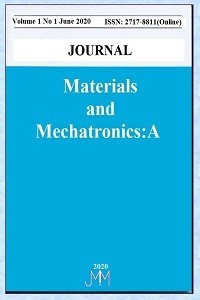AISI P20 Çeliğinin Sonlu Eleman Frezelemesinde Kesme Kuvveti ve Sıcaklığının Parametrik Optimizasyonu
Frezeleme, AISI P20, Sonlu Elemanlar, Kesme kuvveti, Sıcaklık
Parametric Optimization of Cutting Force and Temperature in Finite Element Milling of AISI P20 Steel
Milling, AISI P20, Finite Elements, Cutting force, Temperature,
___
- ASTM, 2022. P20 Steel Plate, https://www.astmsteel.com/product/p20-steel-plate-1-2311-3cr2mo-mold-tool-steel/ (Date of access: 05.04.2022)
- Binali R., Sıcak iş takım çeliğinin (TOOLOX 44) işlenebilirliğinin incelenmesi. Karabük Üniversitesi Fen Bilimleri Enstitüsü, Master Thesis (Printed), 2017.
- Binali R., Coşkun, M., Neşeli, S., An Investigation of Power Consumption in Milling AISI P20 Plastic Mold Steel By Finite Elements Method. Avrupa Bilim ve Teknoloji Dergisi (34), 513-518, 2022.
- Binali R., Yaldız, S., Neseli, S., Parametric optimization for machinability parameters of S960QL structural steel during milling by finite elements. Selcuk University Journal of Engineering Sciences 21(1), 26-31, 2022.
- Binali R., Yaldız, S., Neşeli, S., S960QL Yapı Çeliğinin İşlenebilirliğinin Sonlu Elemanlar Yöntemi ile İncelenmesi. Avrupa Bilim ve Teknoloji Dergisi (31), 85-91, 2021.
- Chinchanikar S., Choudhury S., Effect of work material hardness and cutting parameters on performance of coated carbide tool when turning hardened steel: An optimization approach. Measurement 46(4), 1572-1584, 2013.
- Demir H., Ulaş H. B., Binali R., Toolox 44 malzemesinde talaş kaldırma miktarının yüzey pürüzlülüğü ve takım aşınması üzerindeki etkilerinin incelenmesi. Technological Applied Sciences 13(1), 19-28, 2018.
- Galanis N., Manolakos D. E., Finite element analysis of the cutting forces in turning of femoral heads from AISI 316l stainless steel. In Proceedings of the World Congress on Engineering (Vol. 2), 2014.
- Ghani J. A., Choudhury I., Hassan H., Application of Taguchi method in the optimization of end milling parameters. Journal of Materials Processing Technology 145(1), 84-92, 2004.
- Gok K., Development of three-dimensional finite element model to calculate the turning processing parameters in turning operations. Measurement 75, 57-68, 2015.
- Günay M., Meral T., Korkmaz M. E., AISI 420 Martenzitik paslanmaz çeliğin delinebilirliğinin sonlu elemanlar yöntemiyle analizi. Gazi Mühendislik Bilimleri Dergisi 4(3), 223-229, 2018.
- Günay M., Yaşar N., Sekmen M., Korkmaz M. E., AISI P20 çeliğinin işlenmesinde kesme kuvvetinin deneysel ve nümerik analizi. Gazi University Journal of Science Part C: Design and Technology 4(1), 13-19, 2016.
- Korkmaz M. E., Günay M., Finite element modelling of cutting forces and power consumption in turning of AISI 420 martensitic stainless steel. Arabian Journal for Science and Engineering 43(9), 4863-4870, 2018.
- Kuntoğlu M., Acar O., Gupta M. K., Sağlam H., Sarikaya M., Giasin K., Pimenov D. Y., Parametric optimization for cutting forces and material removal rate in the turning of AISI 5140. Machines 9(5), 90, 2021.
- Kuntoğlu M., Aslan A., Sağlam H., Pimenov D. Y., Giasin K., Mikolajczyk T., Optimization and analysis of surface roughness, flank wear and 5 different sensorial data via tool condition monitoring system in turning of AISI 5140. Sensors 20(16), 4377, 2020.
- Kuntoğlu M., Sağlam H., Investigation of progressive tool wear for determining of optimized machining parameters in turning. Measurement 140, 427-436, 2019.
- Küçüktürk G., Modeling and analyzing the effects of experimentally determined torque and thrust force on cutting tool according to drilling parameters. Proceedings of the Institution of Mechanical Engineers, Part B: Journal of Engineering Manufacture 227(1), 84-95, 2013.
- Li B., Zhang S., Zhang Q., Li L., Simulated and experimental analysis on serrated chip formation for hard milling process. Journal of Manufacturing Processes 44, 337-348, 2019.
- Ozcelik B., Bagci E., Experimental and numerical studies on the determination of twist drill temperature in dry drilling: A new approach. Materials & Design 27(10), 920-927, 2006.
- Ozlu B., Ugur L., Optimization of cutting forces on turning of Ti-6Al-4V Alloy by 3D FEM simulation analysis. Journal of Engineering Research and Applied Science 10(2), 1789-1795, 2021.
- Özel T., Computational modelling of 3D turning: Influence of edge micro-geometry on forces, stresses, friction and tool wear in PcBN tooling. Journal of Materials Processing Technology 209(11), 5167-5177, 2009.
- Saglam H., Unsacar F., Yaldiz, S., Investigation of the effect of rake angle and approaching angle on main cutting force and tool tip temperature. International Journal of Machine Tools and Manufacture 46(2), 132-141, 2006.
- Salur E., Understandings the tribological mechanism of Inconel 718 alloy machined under different cooling/lubrication conditions. Tribology International 174, 107677, 2022.
- Salur E., Aslan A., Kuntoğlu M., Güneş A., Şahin Ö., Optimization of cutting forces during turning of composite materials. Acad. Platf. J. Eng. Sci. 8, 423-431, 2020.
- Shatla M., Kerk C., Altan T., Process modeling in machining. Part I: determination of flow stress data. International Journal of Machine Tools and Manufacture 41(10), 1511-1534, 2001.
- Ucun İ., Aslantas K., Numerical simulation of orthogonal machining process using multilayer and single-layer coated tools. The International Journal of Advanced Manufacturing Technology 54(9), 899-910, 2011.
- Usca Ü. A., Uzun M., Kuntoğlu M., Sap E., Gupta M. K., Investigations on tool wear, surface roughness, cutting temperature, and chip formation in machining of Cu-B-CrC composites. The International Journal of Advanced Manufacturing Technology 116(9), 3011-3025, 2021.
- Zhang J. Z., Chen J. C., Kirby E. D., Surface roughness optimization in an end-milling operation using the Taguchi design method. Journal of Materials Processing Technology 184(1-3), 233-239, 2007.
- Zhang Q., Zhang S., Li J., Three dimensional finite element simulation of cutting forces and cutting temperature in hard milling of AISI H13 steel. Procedia Manufacturing 10, 37-47, 2017.
- Yayın Aralığı: Yılda 2 Sayı
- Başlangıç: 2020
- Yayıncı: Yusuf KAYALI
Derviş ÖZKAN, Garip ERDOĞAN, Yasin OZGURLUK, Gülfem BİNAL, Sefa Erdem YILMAZ, Abdullah KARAOGLANLİ
İbrahim SAVRUKOĞLU, Kubilay ASLANTAS
Zekerya KAYA, Bekir AKSOY, Koray ÖZSOY
Isıl İşlemin Bakır Kaplı Çelik Boruların Mekanik Özelliklerine Etkisinin Araştırılması
Ozan KOYUNCU, Burak ÇELİK, Yasin AKGÜL, Alper İNCESU
Pomza Taşının Otomotiv Sürtünme Malzemesi Olarak Kullanımının Araştırılması
Emin ÇENGELCİ, Hüseyin BAYRAKÇEKEN
